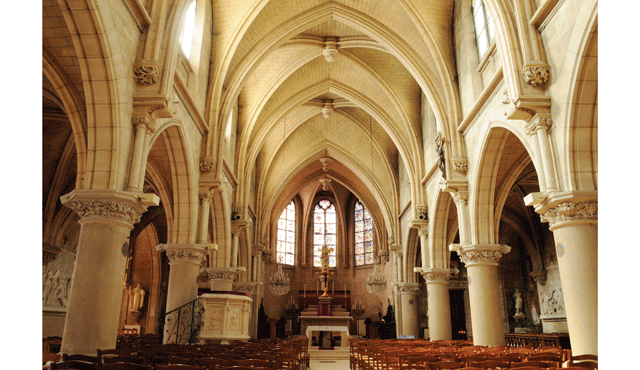Unless you grew up as an altar server, like me, you may not be familiar with the proper names for the different parts of a Catholic Church.
Churches are the houses of God used for many different types of prayer, public and private. Primarily, the church is used for the sacrifice of the Mass and the sacraments, adoration of the Blessed Sacrament, benediction, funeral rites, and the Liturgy of the Hours. It is home to various devotions, including the Rosary, the Stations of the Cross, and private prayer.
The layout of the church building and the sacred objects and furnishings found within it exist to serve these different types of prayer. A typical Catholic Church layout is based on the shape of the crucifix in a format known as the cruciform plan.
Narthex (or Vestibule)
The entry or foyer usually found in the back of the church, where people gather.
Nave
Referring to the ‘barque of Peter’ and ‘Noah’s Ark,’ the word nave is derived from the Latin word for ship and has come to mean the area where the parishioners sit, kneel and stand.
Crossing
The place where the nave, chancel and transept intersect.
Transept
The transverse arm of a cruciform church. Because the liturgy is supposed to be celebrated ad orientem (facing east), the left side of the transept is called the north transept and the right side of the transept is called the south transept.
Sanctuary and choir (chancel)
The word ‘chancel’ comes from the word cancelli, meaning ‘lattice work,’ once used to rail off the choir, where the religious would sit on benches to sing the responses at Mass and chant the Divine Office. The sanctuary is the place where the tabernacle, which holds the Blessed Sacrament, is kept and over which there should always be burning a tabernacle light.
Apse
As the term is commonly used in church architecture, ‘apse’ denotes the often domed, semicircular or polygonal termination where the altar is located.
Altar
The altar is the place where the Eucharistic sacrifice is offered. The altar should be fixed, of natural stone, and contain a relic of a saint (martyrs are favored). The altar is venerated because it is the place of sacrifice.
Pulpit
The podium on the left side of the church as you face the altar, where the Gospel is read. Some churches have a single speaker’s podium called an ambo. Sometimes the left side of the church is known as the Mary side, since statues of the Blessed Virgin are located there.
Lectern
The stand on the right side of the church as you face the altar where the Epistles are read. The right side of the church is often referred to as the Joseph side, since statues of St. Joseph are often located there.
Ambulatory
An ambulatory is a walkway that can be either inside or outside of a structure.
Sacristy (or Vestry)
The sacristy is where sacred vestments and liturgical vessels are stored. In the sacristy you will find the sacrarium, a special sink with a pipe that bypasses the sewer, unlike an ordinary sink, but instead goes straight into the earth. This sink is made thus to preserve the dignity of sacred things which can no longer be used.
Radiating chapels
Cathedrals often have more than one sanctuary and altar; chapels are located around the apse of the church, accessible from the ambulatory.

